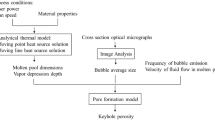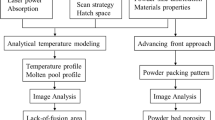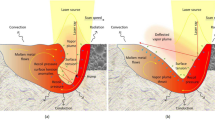Abstract
Porosity is a common process-induced defect in laser powder bed fusion (LPBF) metal additive manufacturing, which will have detrimental effects on the mechanical performance of the fabricated products. In this study, an analytical modeling method with closed-form solutions is developed for the prediction of keyhole-induced porosity in LPBF. A two-dimensional model which considers the keyhole pores formation and trapping is employed to calculate the keyhole porosity, with the molten pool geometries, average pore size, velocity of melt flow, and frequency of pore formation as inputs. An analytical temperature prediction model is used to compute the temperature distribution in LPBF. The molten pool shapes and dimensions are determined by comparing the predicted temperature profiles with melting temperature. The relationship between average pore size and laser power energy density is obtained by regression analysis. The velocity of melt flow and frequency of keyhole pore formation are adapted from the literature. To validate the model, the predictions of keyhole porosity under various process conditions are compared with experimental measurements of Ti6Al4V in LPBF. The predicted results are in good agreement with experimental data, which demonstrates the acceptable predictive accuracy of the proposed model. Also, the analytical modeling method does not include any iteration-based numerical calculations, which makes it computationally efficient. Thus, the proposed model can be an acceptable tool for the fast prediction of keyhole porosity and can also help the researchers understand the physics behind the formation of part porosity.







Similar content being viewed by others
Data availability
Not applicable.
Code availability
Not applicable.
References
Bayat M, Thanki A, Mohanty S, Witvrouw A, Yang S, Thorborg J, Hattel JH (2019) Keyhole-induced porosities in laser-based powder bed fusion (L-PBF) of Ti6Al4V: high-fidelity modelling and experimental validation. Addit Manuf 30:100835. https://doi.org/10.1016/j.addma.2019.100835
Hojjatzadeh SMH, Parab ND, Yan W, Guo Q, Xiong L, Zhao C, Chen L (2019) Pore elimination mechanisms during 3D printing of metals. Nat Commun 10(1):1–8. https://doi.org/10.1038/s41467-019-10973-9
Cunningham R, Zhao C, Parab N, Kantzos C, Pauza J, Fezzaa K, Rollett AD (2019) Keyhole threshold and morphology in laser melting revealed by ultrahigh-speed x-ray imaging. Science 363(6429):849–852. https://doi.org/10.1126/science.aav4687
Dinh TD, Vanwalleghem J, Xiang H, Erdelyi H, Craeghs T, Van Paepegem W (2020) A unified approach to model the effect of porosity and high surface roughness on the fatigue properties of additively manufactured Ti6-Al4-V alloys. Addit Manuf 33:101139. https://doi.org/10.1016/j.addma.2020.101139
Solberg K, Guan S, Razavi SMJ, Welo T, Chan KC, Berto F (2019) Fatigue of additively manufactured 316L stainless steel: the influence of porosity and surface roughness. Fatigue Fract Eng Mater Struct 42(9):2043–2052. https://doi.org/10.1111/ffe.13077
Vastola G, Pei QX, Zhang YW (2018) Predictive model for porosity in powder-bed fusion additive manufacturing at high beam energy regime. Addit Manuf 22:817–822. https://doi.org/10.1016/j.addma.2018.05.042
Gong H, Rafi K, Gu H, Starr T, Stucker B (2014) Analysis of defect generation in Ti–6Al–4V parts made using powder bed fusion additive manufacturing processes. Addit Manuf 1:87–98. https://doi.org/10.1016/j.addma.2014.08.002
Ning J, Wang W, Zamorano B, Liang SY (2019) Analytical modeling of lack-of-fusion porosity in metal additive manufacturing. Appl Phys A 125(11):1–11. https://doi.org/10.1007/s00339-019-3092-9
Qi T, Zhu H, Zhang H, Yin J, Ke L, Zeng X (2017) Selective laser melting of Al7050 powder: melting mode transition and comparison of the characteristics between the keyhole and conduction mode. Mater Des 135:257–266. https://doi.org/10.1016/j.matdes.2017.09.014
Zhao C, Fezzaa K, Cunningham RW, Wen H, De Carlo F, Chen L, Sun T (2017) Real-time monitoring of laser powder bed fusion process using high-speed X-ray imaging and diffraction. Sci Rep 7(1):1–11. https://doi.org/10.1038/s41598-017-03761-2
Shrestha S, Starr T, Chou K (2019) A study of keyhole porosity in selective laser melting: single-track scanning with micro-CT analysis. J Manuf Sci Eng 141(7). https://doi.org/10.1115/1.4043622
King WE, Barth HD, Castillo VM, Gallegos GF, Gibbs JW, Hahn DE, Rubenchik AM (2014) Observation of keyhole-mode laser melting in laser powder-bed fusion additive manufacturing. J Mater Process Technol 214(12):2915–2925. https://doi.org/10.1016/j.jmatprotec.2014.06.005
Slotwinski JA, Garboczi EJ, Hebenstreit KM (2014) Porosity measurements and analysis for metal additive manufacturing process control. J Res Nat Inst Stand Technol 119:494. https://doi.org/10.6028/jres.119.019
Sola A, Nouri A (2019) Microstructural porosity in additive manufacturing: the formation and detection of pores in metal parts fabricated by powder bed fusion. J Adv Manuf Process 1(3):e10021. https://doi.org/10.1002/amp2.10021
Tan JL, Tang C, Wong CH (2018) A computational study on porosity evolution in parts produced by selective laser melting. Metall and Mater Trans A 49(8):3663–3673. https://doi.org/10.1007/s11661-018-4697-x
Bruna-Rosso C, Demir AG, Previtali B (2018) Selective laser melting finite element modeling: validation with high-speed imaging and lack of fusion defects prediction. Mater Des 156:143–153. https://doi.org/10.1016/j.matdes.2018.06.037
Mukherjee T, DebRoy T (2018) Mitigation of lack of fusion defects in powder bed fusion additive manufacturing. J Manuf Process 36:442–449. https://doi.org/10.1016/j.jmapro.2018.10.028
Fergani O, Berto F, Welo T, Liang SY (2017) Analytical modelling of residual stress in additive manufacturing. Fatigue Fract Eng Mater Struct 40(6):971–978. https://doi.org/10.1111/ffe.12560
Ji X, Mirkoohi E, Ning J, Liang SY (2020) Analytical modeling of post-printing grain size in metal additive manufacturing. Opt Lasers Eng 124:105805. https://doi.org/10.1016/j.optlaseng.2019.105805
Wang W, Ning J, Liang SY (2021) In-situ distortion prediction in metal additive manufacturing considering boundary conditions. Int J Precis Eng Manuf 22(5):909–917. https://doi.org/10.1007/s12541-021-00496-z
Van Elsen M, Baelmans M, Mercelis P, Kruth JP (2007) Solutions for modelling moving heat sources in a semi-infinite medium and applications to laser material processing. Int J Heat Mass Transf 50(23–24):4872–4882. https://doi.org/10.1016/j.ijheatmasstransfer.2007.02.044
Promoppatum P, Yao SC, Pistorius PC, Rollett AD (2017) A comprehensive comparison of the analytical and numerical prediction of the thermal history and solidification microstructure of Inconel 718 products made by laser powder-bed fusion. Engineering 3(5):685–694. https://doi.org/10.1016/J.ENG.2017.05.023
Tang M, Pistorius PC, Beuth JL (2017) Prediction of lack-of-fusion porosity for powder bed fusion. Addit Manuf 14:39–48. https://doi.org/10.1016/j.addma.2016.12.001
Ning J, Sievers DE, Garmestani H, Liang SY (2019) Analytical modeling of in-process temperature in powder feed metal additive manufacturing considering heat transfer boundary condition. Int J Precis Eng Manuf-Green Technol 1–9. https://doi.org/10.1007/s40684-019-00164-8
Wang W, Ning J, Liang SY (2021) Prediction of lack-of-fusion porosity in laser powder-bed fusion considering boundary conditions and sensitivity to laser power absorption. Int J Adv Manuf Technol 112(1):61–70. https://doi.org/10.1007/s00170-020-06224-7
Carslaw HS, Jaeger JC (1959) Conduction of heat in solids. Clarendon P
Pang S, Chen W, Wang W (2014) A quantitative model of keyhole instability induced porosity in laser welding of titanium alloy. Metall and Mater Trans A 45(6):2808–2818. https://doi.org/10.1007/s11661-014-2231-3
Abt F, Boley M, Weber R, Graf T, Popko G, Nau S (2011) Novel X-ray system for in-situ diagnostics of laser based processes–first experimental results. Phys Procedia 12:761–770. https://doi.org/10.1016/j.phpro.2011.03.095
Ning J, Mirkoohi E, Dong Y, Sievers DE, Garmestani H, Liang SY (2019) Analytical modeling of 3D temperature distribution in selective laser melting of Ti-6Al-4V considering part boundary conditions. J Manuf Process 44:319–326. https://doi.org/10.1016/j.jmapro.2019.06.013
Yang Y, Knol MF, Van Keulen F, Ayas C (2018) A semi-analytical thermal modelling approach for selective laser melting. Addit Manuf 21:284–297. https://doi.org/10.1016/j.addma.2018.03.002
Gong H, Rafi K, Gu H, Ram GJ, Starr T, Stucker B (2015) Influence of defects on mechanical properties of Ti–6Al–4 V components produced by selective laser melting and electron beam melting. Mater Des 86:545–554. https://doi.org/10.1016/j.matdes.2015.07.147
Gong H, Rafi K, Karthik N, Starr T, Stucker B (2013, August) Defect morphology in Ti–6Al–4V parts fabricated by selective laser melting and electron beam melting. In 24rd Annual International Solid Freeform Fabrication Symposium—An Additive Manufacturing Conference, Austin, TX, Aug (pp. 12–14)
Scharowsky T, Osmanlic F, Singer RF, Körner C (2014) Melt pool dynamics during selective electron beam melting. Appl Phys A 114(4):1303–1307. https://doi.org/10.1007/s00339-013-7944-4
Khairallah SA, Anderson AT, Rubenchik A, King WE (2016) Laser powder-bed fusion additive manufacturing: physics of complex melt flow and formation mechanisms of pores, spatter, and denudation zones. Acta Mater 108:36–45. https://doi.org/10.1016/j.actamat.2016.02.014
Author information
Authors and Affiliations
Corresponding authors
Ethics declarations
Ethics approval
Not applicable.
Consent to participate
Not applicable.
Consent for publication
Not applicable.
Conflict of interest
The authors declare no competing interests.
Additional information
Publisher's Note
Springer Nature remains neutral with regard to jurisdictional claims in published maps and institutional affiliations.
Rights and permissions
About this article
Cite this article
Wang, W., Ning, J. & Liang, S.Y. Analytical prediction of keyhole porosity in laser powder bed fusion. Int J Adv Manuf Technol 119, 6995–7002 (2022). https://doi.org/10.1007/s00170-021-08276-9
Received:
Accepted:
Published:
Issue Date:
DOI: https://doi.org/10.1007/s00170-021-08276-9




